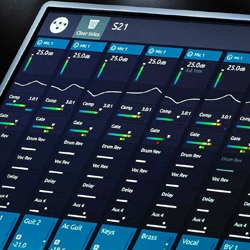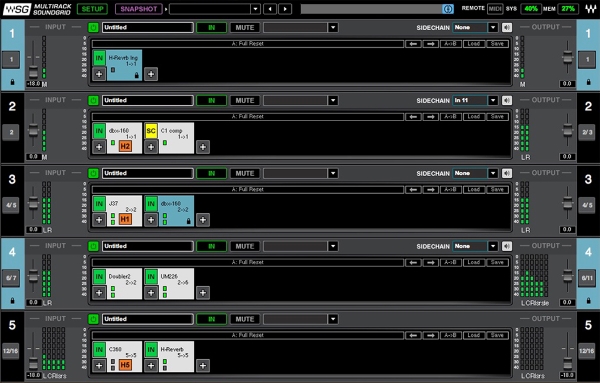
Something else that I find important to know is the location of the input channel’s delay module in the signal chain. Allen & Heath GLD consoles place the delay after the pre-fader bus sends, which allows the user to delay drum inputs through the FOH mix, even when mixing monitors from FOH.
The most common placement for the input delay is right at the beginning of the chain, which drags the stage monitors back in time – no good! It’s common for consoles to offer multiple optional tap locations for inserts and direct outs, something to be aware of.
Need More Plugins?
Don’t worry, it happens to the best of us. Sometimes the onboard effects just don’t cut it, and we need a little something extra. There are several ways to skin this metaphorical cat. Software platforms like Waves MultiRack and Audioström LiveProfessor allow your laptop to act as a plugin host, whereas DiGiGrid SoundGrid and Soundcraft’s Realtime Rack (which has the excellent Universal Audio UAD powered plugins) are two examples of dedicated hardware solutions.
Thanks to the wide acceptance of USB, Dante and MADI interfaces, it’s usually pretty simple to connect an external plugin platform to your console of choice. Some manufacturers have designed their desks to run Waves plugs onboard. Such an integrated solution can save a lot of time and headaches if the plugin requirements are fairly complex. Your best bet is to consult with specific manufacturers to see what options they recommend.
I think it bears mentioning that some users have achieved a limited amount of success using digital audio workstation (DAW) software (Pro Tools, Logic, GarageBand, etc.) as a live plugin host. Do so at your own peril. These programs are designed for recording and editing audio files, so using them as real-time plugin hosts means having the software do something for which its not intended – never a good idea in a critical situation.
There’s the risk of latency and stability issues, and DAW-based setups always seem to fail at the most important moment. If you seek DAW-style functionality, a popular solution is Ableton Live, a full-featured DAW designed and optimized for from the ground up (and appropriately named) for live audio processing.
Running Late
Keep in mind that any DSP operation, no matter how basic, requires time for the calculation to be carried out. For example, a level change of -6.02 dB requires the console’s engine to divide every sample value by 2. Of course, modern processors are blazingly fast, we’re talking microseconds here, but it adds up.
This processing time, called latency, is a special concern when using third-party plugins, as many of them were developed for studio use, where latency is not a pressing concern. But even using only the onboard processing can still lead to trouble.
Imagine that you have two snare drum microphones into two console channels. Now let’s say you add an insert effect on one of them. The input with the inserted effect is going through more steps of DSP, which means that its signal ends up slightly delayed in comparison to the non-processed input. Most of us are familiar with the delay caused by acoustic propagation – a snare hit arrives at the snare mic before it reaches an overhead, and a bass DI will always lead the miked cabinet – and that’s why consoles offer input delay, to offset these effects.
Perhaps less recognized are the relative timing differences between channels that arise due to mismatched processing as they move though the desk. Whenever a signal is recombined electronically at the main mix bus with a delayed version of itself, a comb filter results – a series of alternating summations and cancellations that in many cases can be quite audible.
An important distinction here: We’re not talking about absolute latency (the total time it takes a digital console to pass signal). This issue arises from mismatched relative latency; when some signals take longer to process than others. Differences on the order of 50 microseconds will create comb filtering in the audible spectrum.
How do manufacturers manage this? (Glad you asked!) Solutions to latency management range from just ignoring it (which was a common criticism of many early DAWs) to sophisticated compensation systems, such as the one employ by Midas PRO Series desks. If you tried our dual-snare-mic scenario a PRO console with input insert compensation enabled, for example, the DSP will automatically add the appropriate delay to our non-processed snare channel – and all other inputs – so that when our insert offset finishes with the processed snare send, everything else is waiting, and the whole mix remains phase-matched and coherent.
Again, remember that these types of design facets only deal with latency mismatches created by the DSP. They don’t address sources that come into the desk already mismatched – for that, use a plugin such as Waves InPhase.

